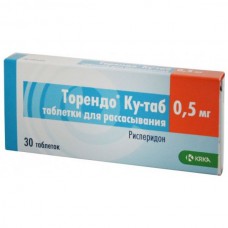Expiration date: 09/2026
Structure and Composition:
Tablets for sucking. One tablet contains risperidone 0.5, 1 or 2 mg
Excipients: mannitol butyl methacrylate copolymer Povidone main MCC giproloza (low-substituted hydroxypropyl cellulose LH-21) Crospovidone Aspartame dye iron oxide red (E172), mint flavors and menthol calcium silicate, magnesium stearate
in blister 10 pcs. In the paper cartons 3 blisters.
Description pharmaceutical form:
0.5 Tablets 1 and 2 mg: round, slightly biconvex tablets of light pink color, with visible inclusions.
Pharmacokinetics:
When administered risperidone completely absorbed (regardless of the meal) and Cmax plasma levels observed after 1-2 h.
Risperidone is metabolized by cytochrome P450 with 2D6 to form a 9-hydroxy-risperidone, which has a similar pharmacological action.
Risperidone and 9-hydroxy-risperidone are effective antipsychotic fraction. Subsequent metabolism of risperidone is N-dealkylation. When administered risperidone is excreted in the T1 / 2 of about 3 hours.
It is found that the T1 / 2 A 9-hydroxy-risperidone, and the active antipsychotic fraction is 24 hours.
In most patients, the equilibrium concentration of risperidone is observed one day after the start of treatment. The equilibrium state of 9-hydroxy-risperidone is reached in most cases within 3-4 days after the start of treatment.
The concentration of risperidone in the plasma is proportional to the dose of the drug (in the range of therapeutic doses).
Risperidone is rapidly distributed in the body. The volume of distribution of 1.2 l / kg. The risperidone plasma associated with albumin and alpha-1-acid glycoprotein. Fraction risperidone is associated plasma protein is 88% in the case of 9-hydroxy-risperidone - 77%.
Excreted by the kidneys - 70% (35-45% of them as a pharmacologically active fraction) and 14% - in the bile. In single dose have high levels of the active plasma concentrations and a slower elimination in elderly patients and patients with poor kidney function.
Description of the pharmacological actions:
Risperidone is an antipsychotic, also has a sedative, antiemetic and hypothermic effect. Risperidone is a selective monoaminergic antagonist with a pronounced affinity for 5-HT2 serotonergic and dopaminergic D2-receptor, also binds to alpha 1-adrenoceptors and at slightly lower affinity of H1-histaminergic and alpha2 adrenergic receptors. It has no affinity for holinoretseptorami.
Antipsychotic effect due to blockade of dopamine D2-receptor and Mesocortical mesolimbic system.
Sedative effect due to blockade of adrenergic receptors of the reticular formation of the brain stem antiemetic - blockade of dopamine receptors trigger zone of the vomiting center hypothermic action - blockade of dopamine receptors of the hypothalamus.
Reduces productive symptoms (delusions, hallucinations), automatism. It causes minimal suppression of motor activity and to a lesser extent induces catalepsy than classic antipsychotics (neuroleptics).
Balanced central antagonism of serotonin and dopamine may reduce the risk of extrapyramidal symptoms.
Risperidone can cause dose-dependent increase in plasma prolactin concentrations.
Indications:
- schizophrenia (acute and chronic) and other psychotic states with productive and / or negative symptoms
- affective disorders in a variety of mental illnesses
- behavioral disturbances in patients with dementia with aggressive manifestation of symptoms (angry outbursts, physical violence), disorders of mental activity (agitation, delirium) or psychotic symptoms
- as adjuvant therapy in the treatment of mania in bipolar disorder
- as adjunctive therapy of behavior disorders in adolescents from 15 years and adult patients with reduced intellectual level or mental retardation, in cases where destructive behavior (aggressiveness, impulsivity, autoaggression) is leading the clinical picture of the disease.
Contraindications:
- Hypersensitivity to the drug
- lactation
- Children up to age 15 years (effectiveness and safety have been established).
Carefully:
- diseases of the cardiovascular system (chronic heart failure, myocardial infarction, conduction disorders of the heart muscle)
- Dehydration and hypovolemia
- cerebrovascular accidents
- Parkinson's disease
- seizures (including history)
- severe renal or hepatic insufficiency (see. dosing recommendations)
- drug abuse or drug dependence (see. dosing recommendations)
- conditions that predispose to the development of tachycardia type "pirouette" (bradycardia, electrolyte imbalance, concomitant drugs prolonging the QT interval)
- brain tumor, intestinal obstruction, acute cases of drug overdose, Reye's syndrome (an antiemetic effect of risperidone may mask the symptoms of these conditions).
Application of pregnancy and breastfeeding:
risperidone safety in pregnant women has not been studied. When pregnancy only be used if a positive effect justifies the potential risk.
Since risperidone and 9-hydroxy-risperidone passes into breast milk, women using the drug should not breast-feed.
Side effect:
From the nervous system: insomnia, agitation, anxiety, headache, sometimes - drowsiness, fatigue, dizziness, impaired concentration, blurred vision, rarely - extrapyramidal symptoms (tremor, rigidity, hypersalivation, bradykinesia, akathisia, acute dystonia), mania or hypomania, stroke (in elderly patients with predisposing factors), as well as hypervolemia (either due to polydipsia or because the syndrome of inappropriate secretion of antidiuretic hormone), tardive dyskinesia (involuntary rhythmic movements mainly language and / or persons), neuroleptic malignant syndrome (hyperthermia, muscle rigidity, autonomic instability functions, impaired consciousness and increased CPK), thermoregulation disorders and seizures.
From the digestive system: constipation, dyspepsia, nausea or vomiting, abdominal pain, increased liver transaminases, dry mouth, hypo- or hypersalivation, anorexia and / or increased appetite, increased or decreased body weight.
Since the cardiovascular system: sometimes - orthostatic hypotension, reflex tachycardia, or increased blood pressure.
From the side of hematopoiesis: neutropenia, thrombocytopenia.
From endocrine system: galactorrhea, gynecomastia, irregular menstruation, amenorrhea, weight gain, hyperglycemia and exacerbation of preexisting diabetes mellitus.
With the genitourinary system: priapism, erectile dysfunction, ejaculation disorder, anorgasmia, urinary incontinence.
Allergic reactions: rhinitis, rash, angioedema, photosensitivity.
For the skin: dry skin, hyperpigmentation, itching, seborrhea.
Other: arthralgia.
Drug Interactions:
Given risperidone has effect primarily on the central nervous system, it should be used with caution in combination with other centrally acting drugs and alcohol.
Risperidone reduces the effectiveness of levodopa or other dopamine agonists.
Clozapine decreases clearance of risperidone.
When using carbamazepine marked reduction in the concentration of the active antipsychotic fraction of risperidone in plasma. Similar effects may be observed with other hepatic enzyme inducers.
Phenothiazines, tricyclic antidepressants and some blockers & beta-can increase the plasma concentrations of risperidone, but this does not affect the concentration of the active antipsychotic fraction.
Fluoxetine can increase the concentration of risperidone in the plasma, but to a lesser extent the concentration of the active fraction antipsychotic, risperidone dose should therefore be corrected.
In the application of risperidone with other drugs that are highly bound to plasma proteins, clinically pronounced displacement of a drug from the plasma protein fraction is observed.
Antihypertensive drugs increase the severity of blood pressure lowering on the background of risperidone.
Dosage and administration:
Sublingual. Tablets for sucking are fragile, they should not be forced through the foil packaging, as they can break. The package is opened by gently pulling the edge of the blister foil, marked by a point and remove the tablet, and then it should be put into the language immediately. Tablet begins to disperse in the mouth within seconds and can be swallowed without water should not be confused as a drug in the mouth with food or crack chewed tablet.
In schizophrenia in adults and children older than 15 years of drug administered 1 or 2 times a day. Initial dose - 2 mg / day. On the second day, the dose should be increased to 4 mg / day. From this point the dose can either maintain the same level, either individually adjusted if necessary. Typically, the optimal dose is 4-6 mg / day. In some cases it may be justified by a slower increase in the dose and lower initial and maintenance doses.
Doses above 10 mg / day did not show a higher efficiency compared to lower doses and may cause the appearance of extrapyramidal symptoms. Due to the fact that the safety of doses above 16 mg / day has not been studied, doses above this level can not be applied.
For information on the use of the drug Torendo Ku tab for the treatment of schizophrenia in children under 15 years are not available.
Elderly patients. Recommended initial dose of 0.5 mg 2 times a day. The dosage can be individually increased by 0.5 mg 2 times per day to 1.2 mg two times a day.
liver and kidney disease recommended initial dose of 0.5 mg 2 times a day. This dose can be gradually increased to 2.1 mg 2 times a day.
Abuse of drugs or drug dependence recommended daily dose - 2-4 mg.
Behavioral disorders in patients with dementia. The recommended initial dose is 0.25 mg 2 times a day (adequate dosage form should be used). The dose may optionally be individually increased by 0.25 mg 2 times a day, no more than a day. For most patients, the optimal dose is 0.5 mg two times a day. However, some patients are shown receiving 1 mg 2 times a day.
Upon reaching the optimal dose of the drug can be recommended 1 time per day.
Mania in bipolar disorder. The recommended initial dose is 2 mg / day in 1 reception. If necessary, this dose may be increased to 2 mg / day, no more than a day. For most patients the optimal dose is 2-6 mg / day.
Conduct disorders in patients with mental retardation.
For patients weighing 50 kg or more. The recommended initial dose is 0.5 mg 1 time per day. If necessary, this dose may be increased to 0.5 mg / day, no more than a day. For most patients, the optimal dose is 1 mg / day. For some patients receiving preferable 0.5 mg / day, while some need to increase the dose of 1.5 mg / day.
For patients weighing less than 50 kg. The recommended initial dose is 0.25 mg 1 time per day. If necessary, this dose may be increased by 0.25 mg / day, no more than a day. For most patients the optimal dose is 0.5 mg / day. For some patients receiving preferable 0.25 mg / day, whereas some require increasing doses up to 0.75 mg / day.
Long-term use of the drug in adolescents should be carried out under the constant supervision of a physician.
Use in children under 15 years is not recommended.
Overdose:
Symptoms: drowsiness, sedation, depression of consciousness, tachycardia, hypotension, extrapyramidal disorder, in rare cases, prolongation of the interval QT.
Treatment: it is necessary to ensure a free airway to ensure adequate oxygenation and ventilation, gastric lavage (after intubation if the patient is unconscious) and the appointment of activated charcoal in combination with laxatives. Symptomatic therapy directed at maintaining vital functions.
For early diagnosis of possible cardiac arrhythmias is necessary as the ECG monitoring can be started quickly. Careful medical supervision and ECG monitoring is carried out to complete disappearance of symptoms of intoxication. There is no specific antidote.
Special instructions:
Transition from other antipsychotic therapy. In schizophrenia, the beginning of treatment with risperidone, we recommend gradually cancel the previous therapy, if clinically justified. If patients are transferred from the depot forms of therapy antipsychotics, risperidone it is recommended to start in place of the next scheduled injection. Periodically assess the need for continued therapy antiparkinsonian drugs. In connection with the & alpha- adrenoceptor blocking effect of risperidone, orthostatic hypotension can occur, especially during the initial dose adjustment. In the event of hypotension should consider lowering the dose. In patients with diseases of the cardiovascular system, as well as dehydration, hypovolemia, or cerebrovascular disorders, the dose should be increased gradually, as recommended (see. "Dosage and administration").
The occurrence of extrapyramidal symptoms is a risk factor for the development of tardive dyskinesia. In case of signs and symptoms of tardive dyskinesia should consider abolishing all antipsychotics. In the event of a neuroleptic malignant syndrome, characterized by hyperthermia, muscle rigidity, autonomic instability functions, impairment of consciousness and increased CPK level is necessary to cancel all antipsychotic drugs, including risperidone.
In case of cancellation of carbamazepine and other hepatic enzyme inducers risperidone dose should be reduced.
Patients should be advised to refrain from eating because of the possibility of weight gain.
During treatment should refrain from activities potentially hazardous activities that require high concentration and psychomotor speed reactions, as well as the intake of alcohol.


